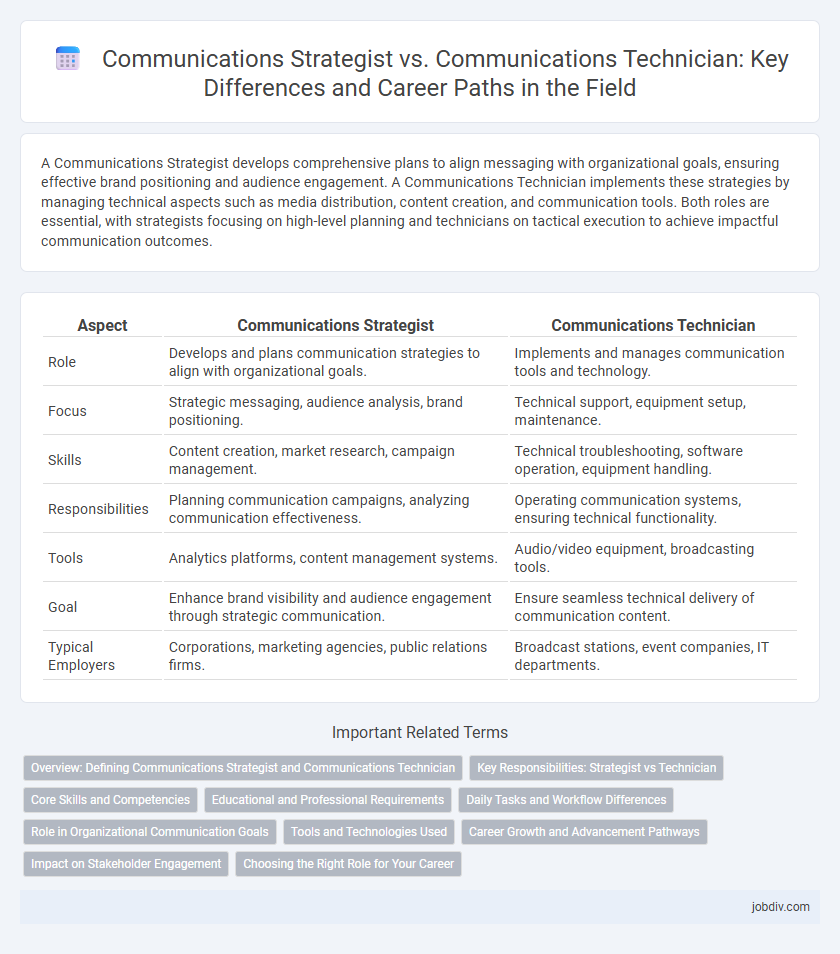A Communications Strategist develops comprehensive plans to align messaging with organizational goals, ensuring effective brand positioning and audience engagement. A Communications Technician implements these strategies by managing technical aspects such as media distribution, content creation, and communication tools. Both roles are essential, with strategists focusing on high-level planning and technicians on tactical execution to achieve impactful communication outcomes.
Table of Comparison
| Aspect | Communications Strategist | Communications Technician |
|---|---|---|
| Role | Develops and plans communication strategies to align with organizational goals. | Implements and manages communication tools and technology. |
| Focus | Strategic messaging, audience analysis, brand positioning. | Technical support, equipment setup, maintenance. |
| Skills | Content creation, market research, campaign management. | Technical troubleshooting, software operation, equipment handling. |
| Responsibilities | Planning communication campaigns, analyzing communication effectiveness. | Operating communication systems, ensuring technical functionality. |
| Tools | Analytics platforms, content management systems. | Audio/video equipment, broadcasting tools. |
| Goal | Enhance brand visibility and audience engagement through strategic communication. | Ensure seamless technical delivery of communication content. |
| Typical Employers | Corporations, marketing agencies, public relations firms. | Broadcast stations, event companies, IT departments. |
Overview: Defining Communications Strategist and Communications Technician
A Communications Strategist develops overarching plans to shape messaging, target audiences, and align communication goals with organizational objectives. A Communications Technician implements technical aspects of communication, such as managing media equipment, producing content, and ensuring smooth transmission of messages. Both roles are essential in achieving effective communication, with strategists focusing on planning and technicians on execution.
Key Responsibilities: Strategist vs Technician
Communications Strategists develop comprehensive messaging frameworks and campaign plans to align with organizational goals, analyze audience insights, and shape brand perception through strategic content. Communications Technicians implement these strategies by managing technical aspects such as media production, distribution channels, and communication tools, ensuring seamless execution and optimization of messages. While strategists focus on planning and messaging architecture, technicians specialize in operational support and technical delivery to maintain effective communication workflows.
Core Skills and Competencies
Communications Strategists excel in developing comprehensive messaging frameworks, audience analysis, and brand positioning, leveraging skills in strategic planning, market research, and persuasive communication. Communications Technicians specialize in implementing communication plans through technical expertise such as media production, digital tools proficiency, and content management systems. The core competencies of Strategists revolve around conceptual thinking and campaign design, while Technicians focus on execution, technical accuracy, and multimedia content creation.
Educational and Professional Requirements
Communications Strategists typically hold a bachelor's or master's degree in communications, marketing, or related fields, with extensive experience in campaign planning, media relations, and content development. Communications Technicians usually require a technical diploma or associate degree, focusing on skills like audio-visual equipment operation, network troubleshooting, and technical support. Professional certifications such as Certified Communications Professional (CCP) enhance strategists' credentials, while technicians benefit from certifications like CompTIA Network+ or AVIXA CTS.
Daily Tasks and Workflow Differences
Communications Strategists focus on developing comprehensive communication plans, crafting key messages, and analyzing audience data to align messaging with organizational goals. Communications Technicians manage the execution of daily communication tasks, such as scheduling social media posts, operating broadcasting equipment, and monitoring communication channels. The strategist's workflow involves research and coordination with multiple departments, while the technician's work is more task-oriented and operational, ensuring seamless delivery of communications content.
Role in Organizational Communication Goals
Communications Strategists develop high-level messaging frameworks and campaign plans aligned with organizational goals to enhance brand perception and stakeholder engagement. Communications Technicians execute these strategies by managing media production, ensuring technical quality, and maintaining communication channels for consistent message delivery. Together, they create a cohesive communication ecosystem that drives strategic objectives and supports organizational success.
Tools and Technologies Used
Communications Strategists utilize advanced analytics platforms, content management systems, and social media monitoring tools to design and optimize comprehensive communication campaigns. Communications Technicians operate broadcasting equipment, audio-visual hardware, and network infrastructure to implement and maintain communication systems. The strategist's toolkit centers on planning and data-driven decision making, while the technician focuses on the technical execution and operational support of communication technologies.
Career Growth and Advancement Pathways
A Communications Strategist typically focuses on high-level planning, brand messaging, and campaign development, offering clear pathways to leadership roles such as Director of Communications or Chief Marketing Officer, emphasizing strategic thinking and decision-making skills. In contrast, a Communications Technician specializes in the technical aspects of communication tools and media production, with career growth often leading to senior technical positions or project management roles within communications departments. Both roles require continuous skill enhancement, but strategists benefit from expanding expertise in analytics and market trends, while technicians grow through mastery of emerging communication technologies.
Impact on Stakeholder Engagement
A Communications Strategist crafts targeted messaging frameworks that enhance stakeholder engagement by aligning communication goals with business objectives. In contrast, a Communications Technician implements and manages communication tools and platforms, ensuring timely and effective message delivery to stakeholders. The strategist's role drives higher engagement through strategic insights, while the technician supports operational efficiency and message clarity.
Choosing the Right Role for Your Career
Choosing between a Communications Strategist and a Communications Technician depends on your career goals and skillset. A Communications Strategist focuses on crafting high-level messaging and developing comprehensive communication plans, requiring strong analytical and leadership skills. In contrast, a Communications Technician handles the technical execution of communication tools and platforms, emphasizing proficiency in software, media production, and operational support.
Communications Strategist vs Communications Technician Infographic

 jobdiv.com
jobdiv.com